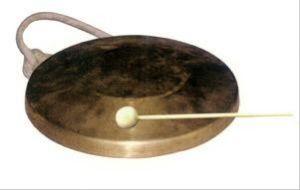Gong
The gong is one of the percussion instruments among China's traditional musical instruments. According to historical records, the sha gong during the Southern and Northern Dynasties (420-589) is the ancestor of today's Chinese gongs. The copper gong unearthed in Luobo Bay of Guangxi Zhuang Autonomous Region is the earliest gong so far known. Textual research indicates it has a history of over 2,000 years.
The gong is a circular copper instrument of various sizes, to be struck with a stick. The smallest can be held in one's palm, while a large one has to be carried by two persons. As an indispensable component of opera accompaniment orchestras and instrumental ensembles, it produces an instantly recognized artistic effect.
The varieties vary, and so do their names according to their shapes, sizes, scopes of use, pitches and tones. The gong used in Peking Opera, called Beijing gong, is small and makes clear, melodious, sonorous sounds. The lion gong, which is only 10 cm in diameter, may be placed on the left palm and struck with thick bamboo sticks by the right hand. The black gong has its edge and center painted black. It is used by folk honor guards to clear the way. From the name, one can tell that the tiger-sound gong makes a loud sound like the roar of a tiger.
Foreigners usually call large gongs that are 50-120 cm in diameter "Chinese gongs." Due to its strong artistic expressivity, large gongs are especially favored by composers. In ancient times, large gongs were beaten to clear the way for officials on inspection tours. When engaging in a battle, two hostile armies would beat drums to bolster the soldiers' moral, and clang gongs to withdraw troops. Gongs were also used in folk activities such as grand festivals, weddings and funerals, to add a magnificent air to the scene.
